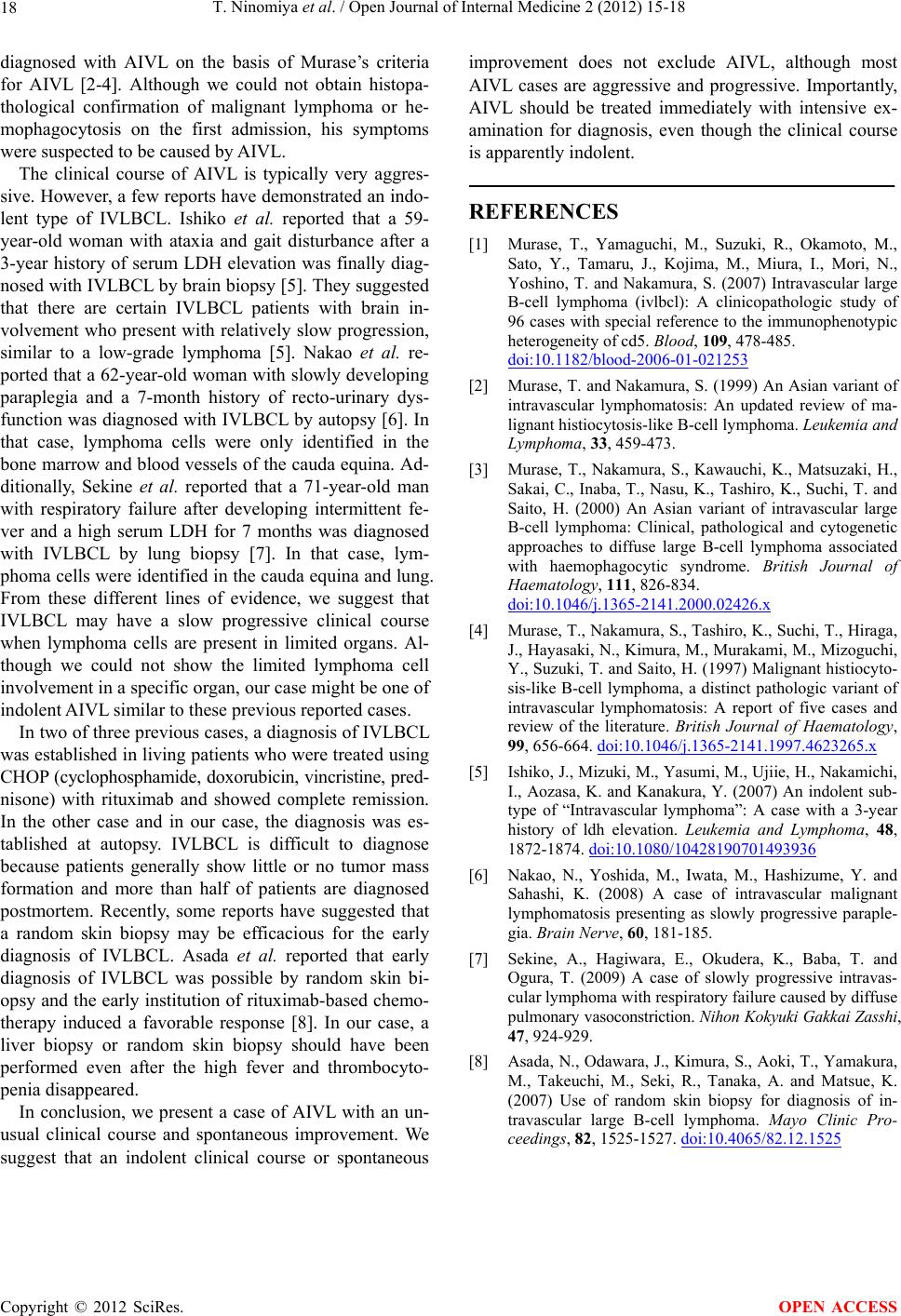
T. Ninomiya et al. / Open Journal of Internal Medicine 2 (2012) 15-18
18
diagnosed with AIVL on the basis of Murase’s criteria
for AIVL [2-4]. Although we could not obtain histopa-
thological confirmation of malignant lymphoma or he-
mophagocytosis on the first admission, his symptoms
were suspected to be caused by AIVL.
The clinical course of AIVL is typically very aggres-
sive. However, a few reports have demonstrated an indo-
lent type of IVLBCL. Ishiko et al. reported that a 59-
year-old woman with ataxia and gait disturbance after a
3-year history of serum LDH elevation was finally diag-
nosed with IVLBCL by brain biopsy [5]. They suggested
that there are certain IVLBCL patients with brain in-
volvement who present with relatively slow progression,
similar to a low-grade lymphoma [5]. Nakao et al. re-
ported that a 62-year-old woman with slowly developing
paraplegia and a 7-month history of recto-urinary dys-
function was diagnosed with IVLBCL by autopsy [6]. In
that case, lymphoma cells were only identified in the
bone marrow and blood vessels of the cauda equina. Ad-
ditionally, Sekine et al. reported that a 71-year-old man
with respiratory failure after developing intermittent fe-
ver and a high serum LDH for 7 months was diagnosed
with IVLBCL by lung biopsy [7]. In that case, lym-
phoma cells were identified in the cauda equina and lung.
From these different lines of evidence, we suggest that
IVLBCL may have a slow progressive clinical course
when lymphoma cells are present in limited organs. Al-
though we could not show the limited lymphoma cell
involvement in a specific organ, our case might be one of
indolent AIVL similar to these previous reported cases.
In two of three previous cases, a diagnosis of IVLBCL
was established in living patients who were treated using
CHOP (cyclophosphamide, doxorubicin, vincristine, pred-
nisone) with rituximab and showed complete remission.
In the other case and in our case, the diagnosis was es-
tablished at autopsy. IVLBCL is difficult to diagnose
because patients generally show little or no tumor mass
formation and more than half of patients are diagnosed
postmortem. Recently, some reports have suggested that
a random skin biopsy may be efficacious for the early
diagnosis of IVLBCL. Asada et al. reported that early
diagnosis of IVLBCL was possible by random skin bi-
opsy and the early institution of rituximab-based chemo-
therapy induced a favorable response [8]. In our case, a
liver biopsy or random skin biopsy should have been
performed even after the high fever and thrombocyto-
penia disappeared.
In conclusion, we present a case of AIVL with an un-
usual clinical course and spontaneous improvement. We
suggest that an indolent clinical course or spontaneous
improvement does not exclude AIVL, although most
AIVL cases are aggressive and progressive. Importantly,
AIVL should be treated immediately with intensive ex-
amination for diagnosis, even though the clinical course
is apparently indolent.
REFERENCES
[1] Murase, T., Yamaguchi, M., Suzuki, R., Okamoto, M.,
Sato, Y., Tamaru, J., Kojima, M., Miura, I., Mori, N.,
Yoshino, T. and Nakamura, S. (2007) Intravascular large
B-cell lymphoma (ivlbcl): A clinicopathologic study of
96 cases with special reference to the immunophenotypic
heterogeneity of cd5. Blood, 109, 478-485.
doi:10.1182/blood-2006-01-021253
[2] Murase, T. and Nakamura, S. (1999) An Asian variant of
intravascular lymphomatosis: An updated review of ma-
lignant histiocytosis-like B-cell lymphoma. Leukemia and
Lymphoma, 33, 459-473.
[3] Murase, T., Nakamura, S., Kawauchi, K., Matsuzaki, H.,
Sakai, C., Inaba, T., Nasu, K., Tashiro, K., Suchi, T. and
Saito, H. (2000) An Asian variant of intravascular large
B-cell lymphoma: Clinical, pathological and cytogenetic
approaches to diffuse large B-cell lymphoma associated
with haemophagocytic syndrome. British Journal of
Haematology, 111, 826-834.
doi:10.1046/j.1365-2141.2000.02426.x
[4] Murase, T., Nakamura, S., Tashiro, K., Suchi, T., Hiraga,
J., Hayasaki, N., Kimura, M., Murakami, M., Mizoguchi,
Y., Suzuki, T. and Saito, H. (1997) Malignant histiocyto-
sis-like B-cell lymphoma, a distinct pathologic variant of
intravascular lymphomatosis: A report of five cases and
review of the literature. British Journal of Haematology,
99, 656-664. doi:10.1046/j.1365-2141.1997.4623265.x
[5] Ishiko, J., Mizuki, M., Yasumi, M., Ujiie, H., Nakamichi,
I., Aozasa, K. and Kanakura, Y. (2007) An indolent sub-
type of “Intravascular lymphoma”: A case with a 3-year
history of ldh elevation. Leukemia and Lymphoma, 48,
1872-1874. doi:10.1080/10428190701493936
[6] Nakao, N., Yoshida, M., Iwata, M., Hashizume, Y. and
Sahashi, K. (2008) A case of intravascular malignant
lymphomatosis presenting as slowly progressive paraple-
gia. Brain Nerve, 60, 181-185.
[7] Sekine, A., Hagiwara, E., Okudera, K., Baba, T. and
Ogura, T. (2009) A case of slowly progressive intravas-
cular lymphoma with respiratory failure caused by diffuse
pulmonary vasoconstriction. Nihon Kokyuki Gakkai Zasshi,
47, 924-929.
[8] Asada, N., Odawara, J., Kimura, S., Aoki, T., Yamakura,
M., Takeuchi, M., Seki, R., Tanaka, A. and Matsue, K.
(2007) Use of random skin biopsy for diagnosis of in-
travascular large B-cell lymphoma. Mayo Clinic Pro-
ceedings, 82, 1525-1527. doi:10.4065/82.12.1525
Copyright © 2012 SciRes. OPEN ACCESS